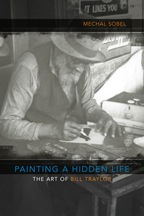
Born into slavery on an Alabama plantation in 1853, Bill Traylor worked as a sharecropper for most of his life. But in 1928 he moved to Montgomery and changed his life, becoming a self-taught lyric painter of extraordinary ability and power. From 1936 to 1946, he sat on a street corner--old, ill, and homeless--and created well over 1,200 paintings.Collected and later promoted by Charles Shannon, a young Montgomery artist, his work received star placement in the Corcoran Gallery's 1982 exhibition "Black Folk Art in America." From then on, the spare and powerful "radical modernity" of Traylor's work helped place him among the rising stars of twentieth-century American artists. Most critics and art historians who analyze Traylor's paintings emphasize his extraordinary form and evaluate the content as either simple or enigmatic narratives of black life. In Painting a Hidden Life, historian Mechal Sobel's trenchant analysis reveals a previously unrecognized central core of meaning in Traylor's near-hidden symbolism--a call for retribution in response to acts of lynching and other violence toward blacks.
Drawing on historical records and oral histories, Sobel carefully explores the relationship between Traylor's life and his paintings and arrives at new interpretations of his art. From an interview with Traylor's great-granddaughter, Sobel learned that Traylor believed the Birmingham policemen who killed his son in 1929 in fact lynched him--a story that neither Traylor nor his family had previously disclosed. The trauma of this event, Sobel explains, propelled Traylor to find a way to voice his rage and spurred the creation of his powerful, mysterious visual language. Traylor's encoded paintings tell a vibrant, multilayered story of conjure power, sexual rivalry, and violence.
Revealing an extraordinarily diverse visual universe, the symbols in Traylor's paintings reflect the worlds he lived in between 1853 and 1949: the plantation conjure milieu into which he was born, the blues culture in which he matured, the world of Jim Crow he learned to secretly violate, and the Catholic values he adopted in his final years. From his African heritage, Traylor drew symbols not readily understood by whites. He mixed traditional African images with conjure signs, with symbols of black Baptists and Freemasons, and with images central to the hidden black protest movement--the cross and the lynching tree.
In this groundbreaking examination of an extraordinary artist, Sobel uncovers the internalized pain of several generations and traces the paths African Americans blazed long before the march down the Selma-Montgomery highway.
Mechal Sobel is the author of four books, including The World They Made Together: Black and White Values in Eighteenth-Century Virginia and Teach Me Dreams: The Search for Self in the Revolutionary Era. She is professor emerita in the department of history at the University of Haifa in Israel, where she lives with her family.
Found an Error? Tell us about it.